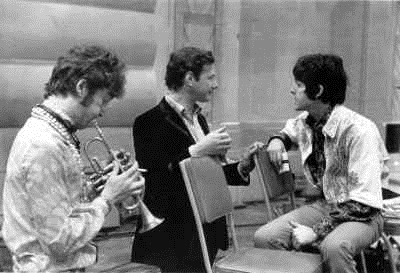The Beatles on Our World: All You Need Is Love
With seemingly unstoppable momentum during the summer of 1967, on May 18th, The Beatles signed a contract to represent the BBC, and Britain, on Our World, the world's first live television satellite link-up to be seen by approximately 400 million people across five continents.
The Beatles' appearance was announced four days later, on May 22nd, John Lennon wrote the song All You Need Is Love especially for the occasion, to the brief given by the BBC: it had to be simple so that viewers around the world would understand it.
"We were big enough to command an audience of that size, and it was for love. It was for love and bloody peace. It was a fabulous time. I even get excited now when I realise that's what it was for: peace and love, people putting flowers in guns." (Ringo Starr)
Our World took place on June 25, 1967. Between the announcement and the broadcast date, The Beatles recorded the rhythm track and some basic vocals.
The satellite link-up was devised by the BBC, which took the idea to the European Broadcasting Union in 1966. The project editor was BBC executive Aubrey Singer. Personalities, including Maria Callas and Pablo Picasso, from 19 nations performed in separate items from their respective countries. The event, which lasted two-and-a-half hours, had the largest television audience to date.
No politicians or heads of state were allowed to take part in the broadcast, and no pre-recorded videotape or film was allowed. Around 10,000 technicians, producers and translators helped make the event happen; each country had its own announcers, with translators narrating where necessary.
For the first time ever, linking five continents and bringing man face to face with mankind, in places as far apart as Canberra and Cape Kennedy, Moscow and Montreal, Samarkand and Söderfors, Takamatsu and Tunis.
National broadcasting companies from 14 countries provided material for the 125-minute programme, which was shown in black-and-white. The organizations involved were: Australia (ABC), Austria (ORF), Canada (CBC), Denmark (DZR), France (ORTF), Italy (RAI), Japan (NHK), Mexico (TS Mexicana), Spain (TVE), Sweden (SRT), Tunisia (RTT), United Kingdom (BBC), USA (NET) and West Germany (ARD), and the programme was also shown - without contributing their own content - in Belgium, Bulgaria, Finland, Ireland, Luxembourg, Monaco, the Netherlands, Norway, Portugal and Switzerland.
In the week before broadcast, seven Eastern bloc countries - led by the Soviet Union - pulled out, apparently in protest to the Western nations' response to the Six Day War.
The Beatles' day began at 2pm with a camera rehearsal in EMI's Studio One. An outside broadcast van was situated in the studio car park, which relayed the signal around the world via the Intelsat I (Early Bird), Intelsat II (Lana Bird) and ATS-1 satellites.
For the live performance, which took place at 9.36pm GMT, The Beatles played along to their pre-recorded backing track. The vocals, bass guitar, guitar solo, drums and 13-piece orchestra were live. To reduce the chances of on-air errors, the event was carefully arranged, although care was taken to make it seem spontaneous.
The televised sequence of events seem a little corny now and studio tapes reveal the considerable rehearsal time which went into the "spontaneous" performance. Using material taped from 5:00 pm up to the actual live sequence, Steve Race introduced the Beatles playing and singing the basic song, the cameras then cut out to the control room where George Martin suggested it was time to bring the orchestra, the musicians filed in, and Mal Evans got into the picture by collecting empty tea cups.


